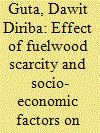| Srl | Item |
| 1 |
ID:
117284


|
|
|
|
|
| Publication |
2013.
|
| Summary/Abstract |
Energy security is central to achieving sustainable development and reducing poverty worldwide. Over 70% of the population of Sub-Saharan Africa, mostly in the rural areas, depend on wood fuel, as firewood or charcoal, to meet their primary domestic energy requirements. This dependence is projected to increase with population growth in the intermediate future, regardless of the implementation of rural electrification programmes.. Fuelwood shortages occur at the localised village level and are a chronic landscape syndrome, becoming more severe over time, with increasing population pressures and competing land-uses. In the South African context, the provision of electricity to rural households at subsidised rates would be expected to provide a viable alternative to fuelwood under conditions of scarcity. This paper compares the fuelwood consumption strategies of households in a fuelwood-scarce environment against those in fuelwood-abundant environment in order to illustrate the inelastic nature of the demand for fuelwood in rural communities, even in the face of severely depleted wood stocks. We seek to understand the mechanisms that households implement to ensure household fuelwood/energy security and how these responses aggregate at the landscape level to shape landscape dynamics. This will aid better planning of intervention policies in the future.
|
|
|
|
|
|
|
|
|
|
|
|
|
|
|
|
| 2 |
ID:
136232


|
|
|
|
|
| Summary/Abstract |
In Ethiopia biomass is predominantly utilized for household energy needs often using inefficient rudimentary stoves which cause adverse environmental and welfare effects. This paper examined the contribution of biomass resources to rural household energy use and energy substitution. The analysis applied the ordinary least square in the final stage estimation of fuelwood and overall biomass energy consumption by using predicted shadow prices. The paper used Tobit model to estimate charcoal and agricultural fuel consumption due to the presence of censoring. An increase in fuelwood shadow price was associated with reduced household fuelwood consumption with price elasticity of −0.38. The cross price elasticity between fuelwood and agricultural fuels revealed no evidence of energy substitution, which conforms to the findings of previous studies. Household access to electricity was associated with lower household biomass energy utilization but kerosene was not fuelwood substitute. Household energy use conformed to the ‘fuel stacking’ or ‘multiple fuel use’ concept, but households preferred modern energy options as welfare increased in areas where modern energy is available. This suggests that there is a promising prospect for fuel-transition, but access to modern energy and economic growth have key roles. The findings suggest that a concerted policy effort is required that would help diversify rural livelihoods, improve living standards and encourage economic growth, encourage inter-fuel substitution through improved modern energy access and afforestation to increase biomass supply.
|
|
|
|
|
|
|
|
|
|
|
|
|
|
|
|